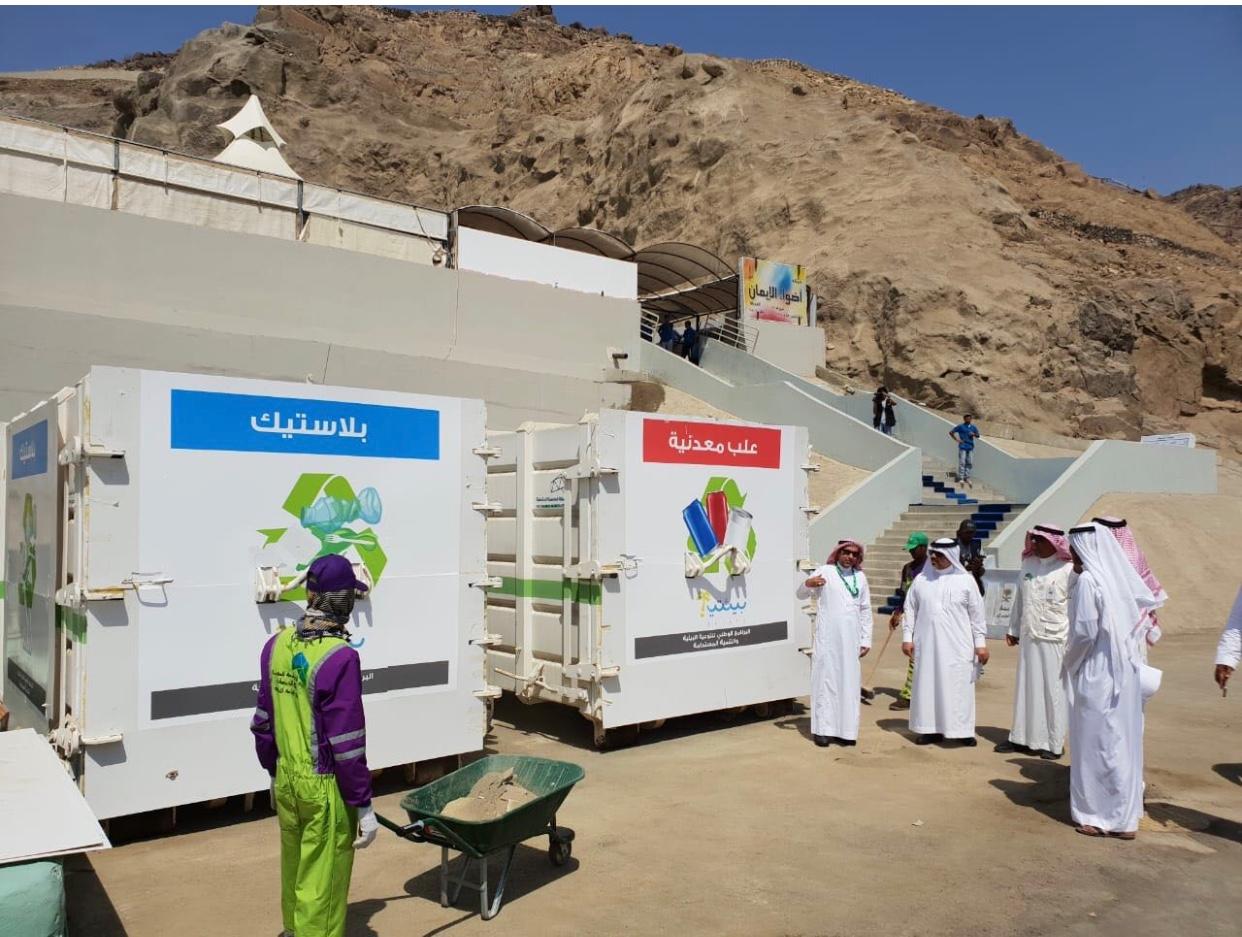Saudi authorities confident of ‘Green Haj’ wider rollout, dedicated fund to be set up
Photo: Separate waste compactors for plastics and aluminium cans seen at the Al-Mashaer Al-Muqaddasa, which consists of Arafat, Muzdalifa and Mina in Saudi Arabia during the haj season in 2018. Photo supplied by the Saudi Environmental Society
Saudi authorities are confident of a wider rollout of the ‘Green Haj’ initiative next year after the project's pilot run during this year's pilgrimage. A dedicated fund will be set up to support the work.
Part of a larger initiative for Mecca, the Green Haj project kicked off during this year’s pilgrimage with eco-friendly waste compactors deployed to parts of the ‘tent city’ of Mina in a bid to reduce environmental pollution.
“Green Haj is a huge initiative which aims to raise awareness and encourage pilgrims to preserve the environment at the holy sites,” Dr Majdah Aburas, supervisor of the Green Haj project and founder and vice president of the non-profit Saudi Environmental Society told Salaam Gateway.
The pilot phase also involved surveying more than 100,000 pilgrims to collect feedback and learn their way of thinking with regards waste and environmental issues.
“After seeing the results of the pilot phase, I am certain that this project is feasible,” said Dr Aburas, who was formerly assistant professor of microbiology and biotechnology at King Abdulaziz University.
She said that she first conceived the idea for Green Haj in 2011 as part of a broader environmental awareness programme she was working on. The government took it on and the initiative was launched this year by Makkah Province Emirate, with the support of Prince Abdullah Bin Bandar bin Abdul Aziz, deputy emir of the holy city, who created a working team to oversee the project.
The committee consisted of senior representatives from the project’s strategic partners: the Ministry of Haj and Umrah, Makkah Province Emirate, Holy Makkah Municipality, the General Authority of Civil Aviation of Saudi Arabia, the Ministry of Environment, Water & Agriculture – Makkah branch, and the Saudi Environmental Society, said Dr Aburas.
“All government entities are cooperating with us and we are very grateful for their support. We eliminated visual pollution, the tents were much cleaner, public health improved, and we protected the environment by preventing any dumping of rubbish and recycling the waste.”

Photo: Recycling bins were deployed to Al-Mashaer Al-Muqaddasa, which consists of Arafat, Muzdalifa and Mina in Saudi Arabia during the haj season in 2018. Photo supplied by the Saudi Environmental Society
WASTE SORTING
The biggest part of the pilot project involved sorting of waste at Mina, home to more than 100,000 tents that this year housed 2.37 million pilgrims. Haj pilgrims stay in Mina for at least three nights during the peak of the haj.
Separate waste compactors for organic and non-organic materials were deployed at 16 select tents.
The compactors were labelled in the language of the pilgrims staying in the respective tents.
Each compactor had a capacity for nine tonnes of waste, compared to the four tonnes of a regular dumpster, according to Dr Aburas.
The compactors did not need to be replaced during the four days of the initiative, saving truck and related logistics expenses.
“About 30,000 tonnes of waste were generated at the holy sites [Al-Mashaer Al-Muqaddasa, consisting of Arafat, Muzdalifa and Mina] during haj. This is as much as the entire waste of Jeddah city over five days,” said Dr Aburas.
Of the 16 tents, the research team placed greater emphasis on three to narrow the focus and make it easier to observe the results.
Those tents, which housed pilgrims from Saudi Arabia, Indonesia and Malaysia, produced 9,400 tons of organic waste and 2,500 tons of non-organic waste, which consist of cartons, plastics and cans.
Sorted waste collected from the pilgrimage sites was sold to companies that handle recycling at the local prices of 3,200 Saudi riyals ($853) per ton of aluminium waste, 570 riyals ($152) per ton of plastic, and 450 riyals ($120) per ton of carton, according to Dr Aburas.

Photo: A banner from Malaysia's Tabung Haji, the national pilgrimage fund, in English, Arabic and Malay promoting cleanliness as a part of faith, displayed at Al-Mashaer Al-Muqaddasa, which consists of Arafat, Muzdalifa and Mina in Saudi Arabia during the haj season in 2018. Photo supplied by the Saudi Environmental Society
COSTS, DEDICATED FUND
Over the next four months, the project’s committee along with a team of 14 experts will start an in-depth study for Green Haj based on the findings of the pilot project. It will then make recommendations on how to roll out the initiative on a wider scale.
Cost analysis will be a key part of the study.
The separate costs of the pilot project, based on each strategic partner’s contributions, will be added up and consolidated. For example, the Makkah Province Emirate supplied the waste compactors and the Holy Makkah Municipality provided rubbish bins.
Cost savings, such as the diversion of waste from landfills to recycling companies, will also be calculated.
With a better understanding of all these costs, the committee will work out the details of a dedicated fund that will be established next haj season and co-managed by the strategic partners of the pilot project.
ROLLOUT
In 2019, Green Haj will be rolled out both indoors and outdoors, inside the tents at Mina and on the roads. According to Dr Aburas, pilgrims consume enormous amounts of water while walking - as much as 80 million bottles were consumed in haj 2017 alone.
Many factors will be taken into consideration when expanding the initiative, such as the diversity of cultures, age groups and mentalities that would need to be approached differently.
For instance, some people have never heard of recycling and don’t understand why they should sort their waste.
The limited space around the holy sites is also a challenge.
“The kingdom makes tremendous efforts to take care of the pilgrims and ensure their comfort – this is a top priority. But we also want to raise people’s awareness and provide mechanisms so that they can also contribute to conserving this sacred environment,” said Dr Aburas, who also previously served as an environmental public awareness specialist with the UN Development Programme (UNDP).
‘GREEN MAKKAH’
Ultimately, Dr Aburas would like to broaden the initiative to cover the entire city of Mecca, reusing and recycling waste materials, creating green jobs, and generating national revenue for the kingdom.
“Green Makkah is my vision – to expand beyond the holy sites to the whole city.”
(Reporting by Heba Hashem; Editing by Emmy Abdul Alim emmy.alim@thomsonreuters.com)
Our Standards: The Thomson Reuters Trust Principles
